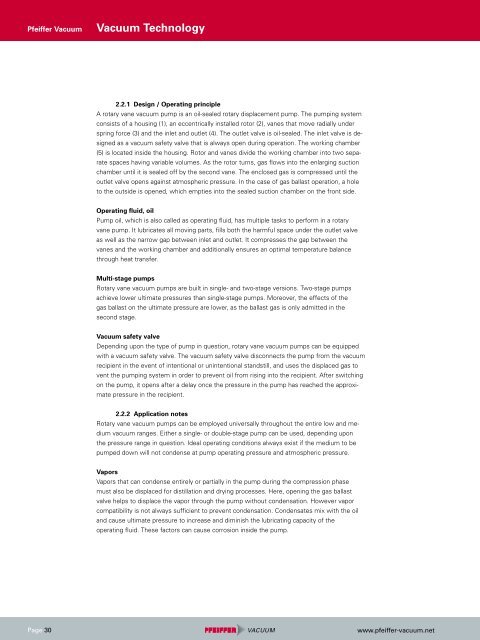You also want an ePaper? Increase the reach of your titles
YUMPU automatically turns print PDFs into web optimized ePapers that Google loves.
Pfeiffer <strong>Vacuum</strong><br />
Page 30<br />
<strong>Vacuum</strong> <strong>Technology</strong><br />
2.2.1 Design / Operating principle<br />
A rotary vane vacuum pump is an oil-sealed rotary displacement pump. The pumping system<br />
consists of a housing (1), an eccentrically installed rotor (2), vanes that move radially under<br />
spring force (3) and the inlet and outlet (4). The outlet valve is oil-sealed. The inlet valve is designed<br />
as a vacuum safety valve that is always open during operation. The working chamber<br />
(5) is located inside the housing. Rotor and vanes divide the working chamber into two separate<br />
spaces having variable volumes. As the rotor turns, gas flows into the enlarging suction<br />
chamber until it is sealed off by the second vane. The enclosed gas is compressed until the<br />
outlet valve opens against atmospheric pressure. In the case of gas ballast operation, a hole<br />
to the outside is opened, which empties into the sealed suction chamber on the front side.<br />
Operating fluid, oil<br />
Pump oil, which is also called as operating fluid, has multiple tasks to perform in a rotary<br />
vane pump. It lubricates all moving parts, fills both the harmful space under the outlet valve<br />
as well as the narrow gap between inlet and outlet. It compresses the gap between the<br />
vanes and the working chamber and additionally ensures an optimal temperature balance<br />
through heat transfer.<br />
Multi-stage pumps<br />
Rotary vane vacuum pumps are built in single- and two-stage versions. Two-stage pumps<br />
achieve lower ultimate pressures than single-stage pumps. Moreover, the effects of the<br />
gas ballast on the ultimate pressure are lower, as the ballast gas is only admitted in the<br />
second stage.<br />
<strong>Vacuum</strong> safety valve<br />
Depending upon the type of pump in question, rotary vane vacuum pumps can be equipped<br />
with a vacuum safety valve. The vacuum safety valve disconnects the pump from the vacuum<br />
recipient in the event of intentional or unintentional standstill, and uses the displaced gas to<br />
vent the pumping system in order to prevent oil from rising into the recipient. After switching<br />
on the pump, it opens after a delay once the pressure in the pump has reached the approximate<br />
pressure in the recipient.<br />
2.2.2 Application notes<br />
Rotary vane vacuum pumps can be employed universally throughout the entire low and medium<br />
vacuum ranges. Either a single- or double-stage pump can be used, depending upon<br />
the pressure range in question. Ideal operating conditions always exist if the medium to be<br />
pumped down will not condense at pump operating pressure and atmospheric pressure.<br />
Vapors<br />
Vapors that can condense entirely or partially in the pump during the compression phase<br />
must also be displaced for distillation and drying processes. Here, opening the gas ballast<br />
valve helps to displace the vapor through the pump without condensation. <strong>How</strong>ever vapor<br />
compatibility is not always sufficient to prevent condensation. Condensates mix with the oil<br />
and cause ultimate pressure to increase and diminish the lubricating capacity of the<br />
operating fluid. These factors can cause corrosion inside the pump.<br />
www.pfeiffer-vacuum.net

















